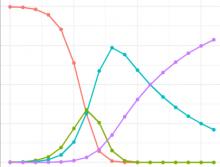Using modelling to investigate the effectiveness of national surveillance monitoring aimed at detecting a Xylella fastidiosa outbreak in Scotland

Xylella fastidiosa is a bacterial plant pathogen that can cause disease in a broad range of hosts. Disease symptoms include leaf scorch, wilting of foliage, dieback and plant death. Xylella fastidiosa was first detected in Europe in 2013 in Puglia in Italy and was identified as subspecies pauca which has gone on to devastate olive plantations in this region. There are currently major Xylella outbreaks in Southern France, including Corsica, Italy, mainland Spain and the Balearic Islands. Although Xylella has so far not been detected in Scotland, an outbreak would have serious impacts on any businesses where Xylella is detected and the wider environment. An essential aspect of ensuring that Xylella is not introduced to Scotland is to establish, through modelling, that national surveillance monitoring aimed at detecting a Xylella outbreak is effective. In addition, it is important to identify which epidemiological parameters most strongly influence the effectiveness of surveillance, to guide where future empirical research should be targeted to reduce any uncertainty.
Impact: This project will contribute to Scottish Government’s preparedness measures for the possible arrival of Xylella fastidiosa by ensuring surveillance monitoring is effective and by identifying the key knowledge gaps for effective surveillance.
Impact: This project will contribute to Scottish Government’s preparedness measures for the possible arrival of Xylella fastidiosa by ensuring surveillance monitoring is effective and by identifying the key knowledge gaps for effective surveillance.
Position:
Group Leader, Ecology Evolution and Environmental Change
Institution: Centre for Ecology and Hydrology
